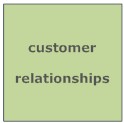 Section
Navigation
Section
Navigation
8. Models and Strategy
8.1 eBusiness in Context: US Scene
8.2 Strategic Management
8.3 Grouping by Strategy
8.4 Business Models
8.5 Customer Segments
8.6 Customer Channels
8.7 Customer Relationships
8.8 Key Resources
8.9 Key Partnerships
8.10 Key Activities
8.11 Value Propositions
8.12 Cost Structure
8.13 Revenue Streams
8.14 Internet Revenue Models
8.15 Strategy
8.16 Company Valuation
8.17 Measures & Ratios
8.18 Fundamental Analysis
8.19 Efficient Markets
8.20 Neoclassical Economics
 8.7
Customer Relationships
8.7
Customer Relationships
Customer Relationships is the building block that describes the types
of relationships a company establishes with specific Customer Segments.
 |
Customer relationships may be driven by one or more
of three motivations: 1. Customer acquisition, 2. Customer retention and 3. Increased sales (upselling). |
Customer relationships may be driven by one or more of three motivations: 1. Customer acquisition, 2. Customer retention and 3. Increased sales (upselling). Motivations commonly change or evolve.
Customer Relationships in the mobile phone market were first driven by acquisition strategies involving free mobile phones. When the market became saturated, operators switched to customer retention and increasing the average revenue per customer.
Companies need to be clear about their motivations, and to analyze performance carefully to establish such benchmarks as: cost of customer acquisition, effectiveness of various marketing approaches, average period of customer retention, integration of motivations with overall company policy.
There are several categories of Customer Relationships, which are not mutually exclusive:
Personal assistance
The human interaction: a customer will communicate with a real company representative for help in the sales process and afterwards. Communication may be at the point of sale, through call centers, by e-mail, blogs, social media or other means.
Dedicated personal assistance
Continuing human interaction between a real company representative and a specific customer, typically over a long period of time. Key account managers who maintain personal relationships with important clients are one example, as are investment banks that serve selected, high-worth individuals.
Self-service
Here the company maintains no direct relationship with customers, but provides the means for customers to help themselves.
Automated services
This is a sophisticated form of customer self-service integrated with with automated processes. Examples are online banking and Internet collaborative services.
Communities
Particularly with the advent of social media sites, companies have sought to create online communities that allow users to exchange knowledge and solve common problems. In turn the companies are kept abreast of customer wants and opinions. GlaxoSmithKline, for example, created a community around alii, a new prescription-free weight-loss product, which allowed it to understand of the challenges faced by overweight adults, and so better manage customer expectations.
Co-creation
Companies are increasing extending the traditional customer-vendor relationship to co-create value with customers. Amazon, for example, encourages customers to write reviews and so create value for other book-lovers. Companies like YouTube.com help customers to create content for public consumption.
Relevant Case Studies
Tesco succeeded with a 'customer first' policy.
Cisco collaborated with customers to see off the competition with innovative technology.
Lulu's PoD services empowered authors.
Lotus Notes was continually re-engineered to maintain its customer base.
Fiat canvassed car buyers and built what was wanted.
Eneco sold a commodity as a premium service to flower-growing companies.
Easy Diagnosis provided a free expert system as a loss-leader for its IT services.
Small, personal companies may weaken their customer relationships by going online.
 Questions
Questions
1. What are customer relationships? Why are they important?
2. What are the three motivations driving customer relationships?
3. With a case study each, illustrate how a company gained and failed
with its customer relationships.
4. What ebusiness topics can help improve customer relationships?
 Sources
and Further Reading
Sources
and Further Reading
1. Business Model Generation: A Handbook for Visionaries,
Game Changers, and Challengers by Alexander Osterwalder and Yves
Pigneur. Wiley 2010.